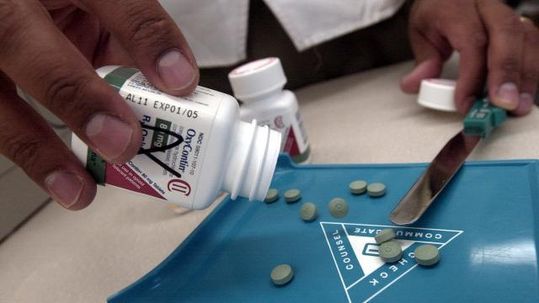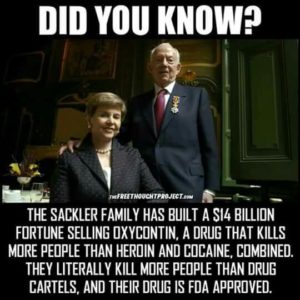
What really drives the opioid epidemic
The opioid epidemic is a real crisis, not a product of public hysteria or media hype.
The data bear that out: the number of Americans dying from opioid overdoses has more than tripled since 2002. Currently, about 50,000 Americans die each year from overdoses, and there are two million Americans addicted to opioids. Entire sections of the country, especially rural areas in the South, the Appalachian region, the Midwest, and even sections of New England have been ravaged by opiates.
These are facts, not fake news. What is fake is the high level of alarm the Trump administration is expressing, which is belied by the slow and pathetic nature of its actions or, more accurately, its lack effective actions. What is fake too is the protestations of innocence by some in the pharmaceutical industry (Pharma), an industry that has played the role of drug pusher in this drama. What is fake is the sudden concern by members of Congress, mainly Republicans, who for years have been receiving millions in campaign contributions from Pharma, including the companies most complicit in the opioid surge. What is fake, finally, is the dominant narrative that blames the economic distress and psychological despair of the former white middle class for 100 percent of the opioid problem. The devastation of the middle class surely is a factor, but it’s hardly the only factor.
Let’s start with the administration. What has Trump said and done so far? Earlier this year he acknowledged the seriousness of the problem. Then this ferocious critic of Washington named a commission to recommend solutions—the archetype of a Washington approach, and one that has seldom worked. Think of the Kerner Commission set up in the wake of the racial unrest of the 1960s. It predicted that unless drastic action was taken the United States would be deeply divided by race. It wasn’t, and now here we are.
The Trump administration, preoccupied by a tangled mess of its own making, took too long, given the urgency, before focusing again on the opioid problem. When it finally did so, its approach was the characteristic smoke-and-mirrors illusion this administration has used for everything that does not involve boosting business or building bombs.
Specifically, by declaring a national public health emergency, Trump tried to cast the impression that he was taking the recommendations of his opioids commission seriously and acting on them vigorously.
The commission had recommended the government declare a national emergency, full stop, no adjectives. The difference is that the declaration of a national emergency directs significant government money to confront the problem while a public health emergency is just a statement. It’s the difference between a fire alarm that may or may not be heard or be ignored and a full-on fire department response to a four-alarm fire.
The title of the main New York Times editorial of October 27 captures Trump’s response accurately: “Words but Little Action on Opioids.”
Corporate culpability, the second piece of the opioid puzzle, and a topic Trump and the GOP Congress are unlikely to ever mention, is described and dissected in a brilliant piece of journalism by Patrick Radden Keefe in the October 30, 2017 issue of The New Yorker (“Empire of Pain: The Sackler family’s ruthless promotion of opioids generated billions of dollars—and millions of addicts”).
Purdue Pharma is the corporate entity that ran the Sackler family’s drug business. Beginning in the 1990’s, it accomplished a tour de force, a successful multi-faceted campaign to transform bedrock assumptions of medical prescribers and thus carve out a much larger role for opioids in the pharmaceutical marketplace. It could serve as the basis for a television series: “How to get away with murder, corporate style.”
Before the Purdue campaign, doctors restricted the use of opioids to terminal cancer patients and a few other classes of patients suffering unendurable pain. After the Purdue campaign, which involved “educating” prescribers and providing thousands of physicians with perks, doctors began prescribing opioids, which they had been assured were safe, for many other conditions. Mass addiction was the predictable result, and a mounting death toll from overdoses followed naturally.

Andrew Kolodny, co-director of the Opioid Policy Research Collaboration (Brandeis University) told the New Yorker that “…the crisis was initially precipitated by a shift in the culture of prescribing—a shift carefully engineered by Purdue.” In addition, Kolodny said:
“If you look at the prescribing trends for all the different opioids, it’s in 1996 that prescribing really takes off…It’s not a coincidence. That’s the year Purdue launched a multifaceted campaign that misinformed the medical community about the risks.”
Beside the pathetic public policy response by the Trump administration and corporate culpability, the third piece of the opioid puzzle is the culture of collusion against the public interest that exists between Pharma and Republicans in Congress.
No story brings together the pieces of this tragic puzzle better than a recent joint investigation by The Washington Post and CBS’s 60 Minutes. It revealed that Pennsylvania Republican Representative Tom Marino, the man nominated by President Trump to be the nation’s “drug czar”, received $100,000 in campaign funds from pharmaceutical companies while shepherding through Congress a law that “weakened the D.E.A.’s power to stop prescription opioids from being shipped to rogue doctors and pharmacies suspected of corruptibly distributing them” (The New York Times, October 20, 2017).
Moreover, the media investigation detailed “how the drug industry had worked behind the scenes with Mr. Marino on the law, helping to draft its language, hiring former DEA lawyers as consultants and showering $1.5 million in donations to Congress” (The New York Times, October 20, 2017).
The opioid crisis is a national emergency and a human tragedy despite Trump’s refusal to call it such or to address it effectively, corporate efforts to keep the gravy train going without regard to the cost in lives, and the tendency of Republicans in Congress to kiss the corporate hand that feeds them lavishly.

